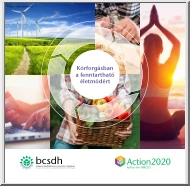A doksi online olvasásához kérlek jelentkezz be!

A doksi online olvasásához kérlek jelentkezz be!
Nincs még értékelés. Legyél Te az első!
Mit olvastak a többiek, ha ezzel végeztek?
Tartalmi kivonat
Felhő alapú üzemeltetési feladatok optimalizálása itSMF Magyarország 11. szeminárium 2015. Október 30 Kozári Ákos (akos.kozari@microsoftcom) Bemutatkozás Kozári Ákos Senior PFE – ITSM Consultancy Akos.Kozari@microsoftcom Microsoft Magyarország Kft. 2 A mai előadás célja • Felhívni a figyelmet a Felhő alapú szolgáltatások, technológiák alkalmazásához kapcsolódó folyamat és emberi/személyzeti feltételek fontosságára. • Kiemelni azokat a területeket, amelyek alapvetően érintettek. • Bemutatni azt, hogy az ITSM terület ezirányú fejlesztésében milyen kezdeti lépések megtételére van szükség (Microsoft alapú megközelítés szerint). IT Megatrends Mobility 70% of CIOs see mobile as most disruptive technology over next decade Mobility = Data security concerns In 2013, 1/3 Social of all new application development will target a mobile form factor Social networking will follow not just people but also
appliances, devices and products Cloud Data > 70% of CIOs will embrace a cloud-first strategy in 2016 Spending on Big Data: $10 billon 2013 > 57% of enterprises will be invested in enterprise social by 2014 54% $20 billion 2016 of organizations plan to increase public cloud spending in 2013 Total digital content will grow 33% Percent of digital universe tagged: 3% (today) (2020) 4 50% = zettabytes From 2012 in 2013 Live video encoding and streaming Web + Mobile 100 million viewers 2.1 million concurrent HD viewers during the USA vs. Canada hockey match Hagyományos környezetek esetén Mi okozza a kieséseket? People Process Technology SOURCE: Four steps to optimize configuration management process and tools Ronni J. Colville October 2013 A Technológia önmagában nem elegendő Compute Inactivity Period t On and Off Unpredictable Bursting Growing Fast Predictable Bursting 24x7 Steady Capacity Needed (Max + 20%) Capacity
Needed (Max + 20%) Save 20-30% S M T W On and Off (30%) T F S Save 60-80% Growing Fast (15%) J F M A Unpredictable Bursting (25%) M J J A S Predictable Bursting (20%) O N D 24x7 Steady (10%) „Heroes can barely run a ship (like many IT departments) and definitely can’t run a navy.” Definíciók Cloud computing is a model for enabling ubiquitous, convenient, ondemand network access to a shared pool of configurable computing resources (e.g, networks, servers, storage, applications, and services) that can be rapidly provisioned and released with minimal management effort or service provider interaction. On-demand self-service Broad network access Resource pooling Rapid elasticity Measured service Infrastruktúra (helyben) Alkalmazások Alkalmazások Adatok Adatok Futtatókörnyezet Futtatókörnyezet Futtatókörnyezet Middleware Middleware Middleware Middleware O/S O/S O/S Virtualizáció Virtualizáció Kiszolgálók
Kiszolgálók Tárolás Tárolás Hálózat Futtatókörnyezet Adatok ügyfél kezeli ügyfél kezeli Adatok Alkalmazások szolgáltató kezeli Virtualizáció Kiszolgálók O/S Virtualizáció Kiszolgálók Tárolás Tárolás Hálózat Hálózat Hálózat IaaS PaaS SaaS szolgáltató kezeli (mint szolgáltatás) szolgáltató kezeli (mint szolgáltatás) (mint szolgáltatás) Alkalmazások ügyfél kezeli Szoftver Platform Private cloud Hybrid cloud Public cloud Community cloud Cloud Services Foundation Reference Model Service Delivery Business Relationship Management Capacity Management Define Availability and Continuity Management Information Security Management Enable services Define Software Manage and support Platform Infrastructure Provide capability Compute Network Storage Service Level Management Enable services Consumer and Provider Portal Usage and Billing Service Reporting Service Lifecycle Management
Define Service Operations Request Fulfillment Access Management Service Monitoring Asset and Configuration Management Systems Administration Service Management Configuration Management Change Management Knowledge Management Authorization Authentication Release and Deployment Management Incident and Problem Management Directory Data Protection Deployment and Provisioning Process Automation Fabric Management Network Support Define Support Provide capability Virtualization http://blogs.technetcom/b/cloudsolutions/arch ive/2013/08/15/cloud-services-foundationreference-architecture-reference-model.aspx Financial Management Management and Support Provide capability Minimum operational processes, and technical capabilities that are necessary to provide any services Regulatory Policy and Compliance Management This diagram is updated periodically. The latest version can be found online. Version 1 Detailed information about this diagram is provided in the Cloud
Services Foundation Reference Model article. Principles (general rules, guidelines to support cloud services foundation) Take a Service Provider’s Approach Optimization of Resource Usage http://blogs.technetcom/b/clouds olutions/archive/2013/08/15/cloud -services-foundation-referencearchitecture-principles-concepts11/6/2015 and-patterns.aspx Incentivize Desired Behavior Take a Holistic Approach to Availability Design Create a Seamless User Experience Minimize Human Involvement Drive Predictability Achieve Business Value through Measured Continual Improvement Perception of Infinite Capacity Perception of Continuous Service Availability Concepts Favor Resiliency Over Redundancy Pool Compute Resources Service Classification Fabric Management Consumption Based Pricing Elastic Infrastructure Partitioning of Shared Resources Cost Transparency Homogenization of Physical Hardware Resource Decay http://blogs.technetcom/b/clouds olutions/archive/2013/08/15/cloud
-services-foundation-referencearchitecture-principles-conceptsand-patterns.aspx Security and Identity Virtualized Infrastructure Multi tenancy Cloud Principles What is the vision? Take a Service Provider’s Approach Optimization of Resource Usage Where are we now? Analysis Where do we want to be? Short and longer term program What are the expected benefits? Take a Holistic Approach to Availability Design Create a Seamless User Experience Favor Resiliency Over Redundancy Predictability Pool Compute Resources Service Classification Fabric Management Consumption Based Pricing Drive Predictability Context, Business Objectives Incentivize Desired Behavior Continous improvement Minimize Human Involvement Achieve Business Value through Measured Continual Improvement Perception of Infinite Capacity Cloud Services Foundation Reference Model Cloud Concepts Perception of Continuous Service Availability Resource Decay Virtualized Infrastructure Elastic
Infrastructure Partitioning of Shared Resources Security and Identity Multi tenancy Cost Transparency Homogenization of Physical Hardware PROCESSES: Incident Management Problem Management Request Fulfilment Event Management Service Asset & Configuration Management Change Management Release & Deployment Management Knowledge Management Access Management Process optimization How do We get there? Benefits Management People (Human Resource and RACI optimization) Külső, belső kontextus Technology improvement Célok, elvárások Hasznok, előnyök Javasolt változtatások Measurement and metrics Did we get there? Governance, periodic review Megoldások (projektek, technológia) Customer Provided services SERVICE DELIVERY PROCESSES Business Relationship Management Availability and Continuity Management Capacity Management Information Security Management Enable services Define Regulatory Policy and Compliance Management
Financial Management Service Level Management Enable services Define Define MANAGEMENT AND SUPPORT TECHNICAL CAPABILITIES SOFTWARE Provide capability Continuous improvement Provide capability Manage and support PLATFORM Consumer and Provider Portal Usage and Billing Service Reporting Service Monitoring Service Management Configuration Management Authorization Authentication Directory Data Protection Deployment and Provisioning Process Automation Fabric Management Network Support Provide capability INFRASTRUCTURE Provide capability Service Lifecycle Management SERVICE OPERATIONS PROCESSES Define Support Request Fulfillment Access Management Asset and Configuration Management Systems Administration Change Management Knowledge Management Release and Deployment Management Incident and Problem Management Operations Support Virtualization Compute Network Storage Management Platform (MP) Responsible for controlling the life cycle of all
changes. Minimize Human Involvement Favor Resiliency Over Redundancy Drive Predictability Perception of Continuous Availability Take a Service Provider’s Approach Service Operations Request Fulfillment Access Management Asset and Configuration Management Systems Admnistration Change Management Knowledge Management Release and Deployment Management Incident and Problem Management Responsible for maintaining information on the assets, components, and infrastructure needed to provide a service. Critical configuration data for each component, and its relationship to other components. Mature Service Asset and Configuration Management processes are necessary for achieving predictability. Virtualized Infrastructure Fabric Management Service Operations Request Fulfillment Access Management Asset and Configuration Management Systems Admnistration Change Management Knowledge Management Release and Deployment Management Incident and Problem Management Service
Operations Virtualized Infrastructure Minimize Human Involvement Resource Decay Request Fulfillment Access Management Asset and Configuration Management Systems Admnistration Change Management Knowledge Management Release and Deployment Management Incident and Problem Management Responsible for manage requests for service from users. Take a Service Provider’s Approach Encourage Desired Consumer Behavior Minimize Human Involvement Service Operations Request Fulfillment Access Management Asset and Configuration Management Systems Admnistration Change Management Knowledge Management Release and Deployment Management Incident and Problem Management Szervezet 11/6/2015 28 Kihatás az ITSM folyamatokra Új szerepkörök, ismeretek Változás a felelőségi körökben Javasolt gyakorlat Jelenleg működtetett folyamatok/szervezet Új, Felhő szolgáltatásokat működtető szervezet SaaS Business Service Cloud Service Models will impact
the role model PaaS IaaS Service Consumer Service Delivery Software Service Consumer Service Delivery Service Consumer Platform Service Delivery 11/6/2015 Fabric Service Provider Service Provider Service Provider Felhő környezethez kapcsolódó szerepkörök (példák) https://support.officecom/en-us/article/Assigning-admin-roles-in-Office365-eac4d046-1afd-4f1a-85fc-8219c79e1504?ui=en-US&rs=enUS&ad=US 11/6/2015 Összefoglalás
appliances, devices and products Cloud Data > 70% of CIOs will embrace a cloud-first strategy in 2016 Spending on Big Data: $10 billon 2013 > 57% of enterprises will be invested in enterprise social by 2014 54% $20 billion 2016 of organizations plan to increase public cloud spending in 2013 Total digital content will grow 33% Percent of digital universe tagged: 3% (today) (2020) 4 50% = zettabytes From 2012 in 2013 Live video encoding and streaming Web + Mobile 100 million viewers 2.1 million concurrent HD viewers during the USA vs. Canada hockey match Hagyományos környezetek esetén Mi okozza a kieséseket? People Process Technology SOURCE: Four steps to optimize configuration management process and tools Ronni J. Colville October 2013 A Technológia önmagában nem elegendő Compute Inactivity Period t On and Off Unpredictable Bursting Growing Fast Predictable Bursting 24x7 Steady Capacity Needed (Max + 20%) Capacity
Needed (Max + 20%) Save 20-30% S M T W On and Off (30%) T F S Save 60-80% Growing Fast (15%) J F M A Unpredictable Bursting (25%) M J J A S Predictable Bursting (20%) O N D 24x7 Steady (10%) „Heroes can barely run a ship (like many IT departments) and definitely can’t run a navy.” Definíciók Cloud computing is a model for enabling ubiquitous, convenient, ondemand network access to a shared pool of configurable computing resources (e.g, networks, servers, storage, applications, and services) that can be rapidly provisioned and released with minimal management effort or service provider interaction. On-demand self-service Broad network access Resource pooling Rapid elasticity Measured service Infrastruktúra (helyben) Alkalmazások Alkalmazások Adatok Adatok Futtatókörnyezet Futtatókörnyezet Futtatókörnyezet Middleware Middleware Middleware Middleware O/S O/S O/S Virtualizáció Virtualizáció Kiszolgálók
Kiszolgálók Tárolás Tárolás Hálózat Futtatókörnyezet Adatok ügyfél kezeli ügyfél kezeli Adatok Alkalmazások szolgáltató kezeli Virtualizáció Kiszolgálók O/S Virtualizáció Kiszolgálók Tárolás Tárolás Hálózat Hálózat Hálózat IaaS PaaS SaaS szolgáltató kezeli (mint szolgáltatás) szolgáltató kezeli (mint szolgáltatás) (mint szolgáltatás) Alkalmazások ügyfél kezeli Szoftver Platform Private cloud Hybrid cloud Public cloud Community cloud Cloud Services Foundation Reference Model Service Delivery Business Relationship Management Capacity Management Define Availability and Continuity Management Information Security Management Enable services Define Software Manage and support Platform Infrastructure Provide capability Compute Network Storage Service Level Management Enable services Consumer and Provider Portal Usage and Billing Service Reporting Service Lifecycle Management
Define Service Operations Request Fulfillment Access Management Service Monitoring Asset and Configuration Management Systems Administration Service Management Configuration Management Change Management Knowledge Management Authorization Authentication Release and Deployment Management Incident and Problem Management Directory Data Protection Deployment and Provisioning Process Automation Fabric Management Network Support Define Support Provide capability Virtualization http://blogs.technetcom/b/cloudsolutions/arch ive/2013/08/15/cloud-services-foundationreference-architecture-reference-model.aspx Financial Management Management and Support Provide capability Minimum operational processes, and technical capabilities that are necessary to provide any services Regulatory Policy and Compliance Management This diagram is updated periodically. The latest version can be found online. Version 1 Detailed information about this diagram is provided in the Cloud
Services Foundation Reference Model article. Principles (general rules, guidelines to support cloud services foundation) Take a Service Provider’s Approach Optimization of Resource Usage http://blogs.technetcom/b/clouds olutions/archive/2013/08/15/cloud -services-foundation-referencearchitecture-principles-concepts11/6/2015 and-patterns.aspx Incentivize Desired Behavior Take a Holistic Approach to Availability Design Create a Seamless User Experience Minimize Human Involvement Drive Predictability Achieve Business Value through Measured Continual Improvement Perception of Infinite Capacity Perception of Continuous Service Availability Concepts Favor Resiliency Over Redundancy Pool Compute Resources Service Classification Fabric Management Consumption Based Pricing Elastic Infrastructure Partitioning of Shared Resources Cost Transparency Homogenization of Physical Hardware Resource Decay http://blogs.technetcom/b/clouds olutions/archive/2013/08/15/cloud
-services-foundation-referencearchitecture-principles-conceptsand-patterns.aspx Security and Identity Virtualized Infrastructure Multi tenancy Cloud Principles What is the vision? Take a Service Provider’s Approach Optimization of Resource Usage Where are we now? Analysis Where do we want to be? Short and longer term program What are the expected benefits? Take a Holistic Approach to Availability Design Create a Seamless User Experience Favor Resiliency Over Redundancy Predictability Pool Compute Resources Service Classification Fabric Management Consumption Based Pricing Drive Predictability Context, Business Objectives Incentivize Desired Behavior Continous improvement Minimize Human Involvement Achieve Business Value through Measured Continual Improvement Perception of Infinite Capacity Cloud Services Foundation Reference Model Cloud Concepts Perception of Continuous Service Availability Resource Decay Virtualized Infrastructure Elastic
Infrastructure Partitioning of Shared Resources Security and Identity Multi tenancy Cost Transparency Homogenization of Physical Hardware PROCESSES: Incident Management Problem Management Request Fulfilment Event Management Service Asset & Configuration Management Change Management Release & Deployment Management Knowledge Management Access Management Process optimization How do We get there? Benefits Management People (Human Resource and RACI optimization) Külső, belső kontextus Technology improvement Célok, elvárások Hasznok, előnyök Javasolt változtatások Measurement and metrics Did we get there? Governance, periodic review Megoldások (projektek, technológia) Customer Provided services SERVICE DELIVERY PROCESSES Business Relationship Management Availability and Continuity Management Capacity Management Information Security Management Enable services Define Regulatory Policy and Compliance Management
Financial Management Service Level Management Enable services Define Define MANAGEMENT AND SUPPORT TECHNICAL CAPABILITIES SOFTWARE Provide capability Continuous improvement Provide capability Manage and support PLATFORM Consumer and Provider Portal Usage and Billing Service Reporting Service Monitoring Service Management Configuration Management Authorization Authentication Directory Data Protection Deployment and Provisioning Process Automation Fabric Management Network Support Provide capability INFRASTRUCTURE Provide capability Service Lifecycle Management SERVICE OPERATIONS PROCESSES Define Support Request Fulfillment Access Management Asset and Configuration Management Systems Administration Change Management Knowledge Management Release and Deployment Management Incident and Problem Management Operations Support Virtualization Compute Network Storage Management Platform (MP) Responsible for controlling the life cycle of all
changes. Minimize Human Involvement Favor Resiliency Over Redundancy Drive Predictability Perception of Continuous Availability Take a Service Provider’s Approach Service Operations Request Fulfillment Access Management Asset and Configuration Management Systems Admnistration Change Management Knowledge Management Release and Deployment Management Incident and Problem Management Responsible for maintaining information on the assets, components, and infrastructure needed to provide a service. Critical configuration data for each component, and its relationship to other components. Mature Service Asset and Configuration Management processes are necessary for achieving predictability. Virtualized Infrastructure Fabric Management Service Operations Request Fulfillment Access Management Asset and Configuration Management Systems Admnistration Change Management Knowledge Management Release and Deployment Management Incident and Problem Management Service
Operations Virtualized Infrastructure Minimize Human Involvement Resource Decay Request Fulfillment Access Management Asset and Configuration Management Systems Admnistration Change Management Knowledge Management Release and Deployment Management Incident and Problem Management Responsible for manage requests for service from users. Take a Service Provider’s Approach Encourage Desired Consumer Behavior Minimize Human Involvement Service Operations Request Fulfillment Access Management Asset and Configuration Management Systems Admnistration Change Management Knowledge Management Release and Deployment Management Incident and Problem Management Szervezet 11/6/2015 28 Kihatás az ITSM folyamatokra Új szerepkörök, ismeretek Változás a felelőségi körökben Javasolt gyakorlat Jelenleg működtetett folyamatok/szervezet Új, Felhő szolgáltatásokat működtető szervezet SaaS Business Service Cloud Service Models will impact
the role model PaaS IaaS Service Consumer Service Delivery Software Service Consumer Service Delivery Service Consumer Platform Service Delivery 11/6/2015 Fabric Service Provider Service Provider Service Provider Felhő környezethez kapcsolódó szerepkörök (példák) https://support.officecom/en-us/article/Assigning-admin-roles-in-Office365-eac4d046-1afd-4f1a-85fc-8219c79e1504?ui=en-US&rs=enUS&ad=US 11/6/2015 Összefoglalás




 Útmutatónk teljes körűen bemutatja az angoltanulás minden fortélyát, elejétől a végéig, szinttől függetlenül. Ha elakadsz, ehhez az íráshoz bármikor fordulhatsz, biztosan segítségedre lesz. Egy a fontos: akarnod kell!
Útmutatónk teljes körűen bemutatja az angoltanulás minden fortélyát, elejétől a végéig, szinttől függetlenül. Ha elakadsz, ehhez az íráshoz bármikor fordulhatsz, biztosan segítségedre lesz. Egy a fontos: akarnod kell!